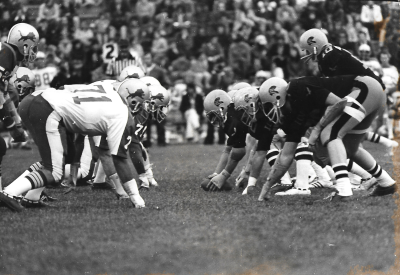By Larry Cotlar
Every year since 2007, a pair of National Football League teams have played a regular season game overseas in London. In fact, from 1991 through 2007, the NFL sponsored The World League of American Football (later renamed the World League) in which three teams were based in Europe: Frankfurt, Barcelona and London.
However, a semipro team from Newton was one of two teams which first played a professional football game in Europe.
On Memorial Day 1977, the Newton Nite Hawks and Chicago Lions took off from O’Hare Airport and flew across the Atlantic Ocean, eventually landing in Brussels to play a series of five games in three different countries. Games were played in Versailles and Lille, France; Landstuhl Air Force Base near Kaiserslautern, West Germany; and Gratz and Vienna, Austria. Even though the Nite Hawks won all five games, that’s not what the players who made the trip remember most about that historic jaunt across the Atlantic.
Quarterback Stanley Allspach calls the trip one of the highlights of his football career.
“We played in front of some good crowds and got to know the people in the hotels in which we stayed,” he said. “We got to see some very interesting places.”
Cornerback Doug Fisher, one of the team’s founding fathers, remembered the trip fondly.
“I was one of a handful of couples who took their wives along. We played a lot of poker and I won a lot of money. Some of the guys were broke before we even got to Europe,” he said with a chuckle.
However, there were some challenges along the way, especially one which caused quite a bit of angst.
“When we were in Vienna, the promoter took off with $5,000 and we had no money with which to pay our bills,” said Allspach. “We had sent our money back to Newton. The State Department had to get involved. They made sure our money got wired back. Otherwise we might not have been able to board the plane which took us to Munich for the last game of the tour.”
The history of the Newton Night Hawks is one for the record books. The team was the brainchild of Jim Foster, who later founded the Arena Football League. Foster graduated from the University of Iowa in 1972, where he ran track and wanted to play football, but didn’t make the Hawkeye squad.
He was hired to work in marketing at the Maytag Corporation in Newton in September 1972. During that time, he began working at a Fellowship of Christian Athletes camp at St. Olaf’s College in Minnesota. A couple of Minnesota Vikings players also came to the camp, started tossing a football with Foster and remarked that it was too bad that he had never played football.
Foster knew of a semipro football team in Des Moines called the Vikings. He called them and learned that they were missing a wide receiver. Foster asked for a tryout and wound up making the team (which also featured the aforementioned Allspach at quarterback).
The Des Moines Vikings ceased operations after that season. Foster said that he hated seeing the Vikings fold and wanted to try to bring the team back, but got little traction in 1973. However in the spring of 1974, Foster was approached by Tom Renda, a Des Moines legislator, lawyer and judge, and Jerry Wieslander, a Drake University assistant football coach, who asked Foster if he would be interested in putting the team back together. Then came a casual meeting which wound up having a major impact on the team’s future.
“I was having lunch in Newton,” said Foster, “when Bernie Berntsen, who ran the Newton Drugtown walked in. When I floated the idea of reforming the Vikings, he asked ‘Why not put the team right here in Newton? We need something to do here and it would be good for the community.’ That planted the seed for the creation of the Nite Hawks.”
TO READ MORE ABOUT THIS STORY AND OTHER FASCINATING STORIES ABOUT IOWA HISTORY, subscribe to Iowa History Journal. You can also purchase back issues at the store.

